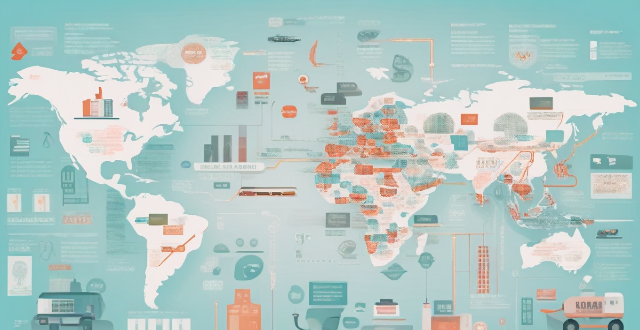Species Management

How do invasive species affect biodiversity ?
Invasive species can have a significant impact on native biodiversity, both positively and negatively. They can outcompete and replace native species, leading to changes in community structure and ecosystem function. Invasive species can also cause damage to infrastructure and human health through the spread of disease or destruction of habitats. Management strategies for invasive species include prevention measures such as quarantines and biosecurity protocols, as well as control measures such as eradication programs and habitat restoration. It is important to consider the costs and benefits of each strategy when developing a management plan.

How do invasive species interact with climate change to threaten native biodiversity ?
Invasive species and climate change pose significant threats to native biodiversity by exacerbating range expansion, altering competition, increasing predation pressure, degrading habitats, facilitating disease transmission, disrupting mutualisms, having synergistic effects, depleting resources, displacing keystone species, and reducing ecosystem resilience. Integrated management strategies are crucial for mitigating these threats and include habitat restoration, invasive species control, protection of keystone species, and conservation of diverse genetic pools within native species to enhance their adaptability.

Can climate change cause extinction of certain species ?
Climate change has the potential to cause the extinction of certain species through a variety of mechanisms including rising temperatures, changes in precipitation patterns, loss of habitat, and disruption of food webs. It is essential that we take action to mitigate the effects of climate change and protect vulnerable species before it's too late.

What role do protected areas play in maintaining biodiversity ?
The article discusses the importance of protected areas in maintaining biodiversity, highlighting their roles in habitat preservation, species protection, and ecosystem services. It also addresses the challenges of effective management, connectivity, and global cooperation for conservation efforts. The text emphasizes that protected areas are essential for safeguarding endangered species, supporting ecological processes, and mitigating climate change, but their success depends on balanced management, sufficient resources, and international collaboration.

How should we prioritize the protection of endangered species and ecosystems ?
The protection of endangered species and ecosystems is a critical issue that requires immediate attention. Here are some strategies we can employ to prioritize their protection: 1. Conduct comprehensive surveys and studies to identify and understand the current state of endangered species and ecosystems. 2. Develop effective legislation and policies, such as establishing protected areas, regulating hunting and fishing, and promoting sustainable development. 3. Raise public awareness and involvement through education programs, community involvement, and media campaigns. 4. Collaborate internationally by signing international agreements, sharing knowledge and resources, and coordinating conservation efforts. By taking these steps, we can work towards ensuring the survival of our planet's diverse flora and fauna for future generations.

How might climate change influence the distribution and abundance of aquatic species ?
Climate change significantly impacts the distribution and abundance of aquatic species by altering water temperature, pH levels, salinity, and oxygen availability. These changes affect habitats and life cycles of aquatic organisms, causing direct and indirect effects on their survival, growth, reproduction, and community interactions. Some species show resilience through genetic adaptation or phenotypic plasticity. Proactive conservation efforts are crucial for maintaining biodiversity and ecosystem health amid climate shifts.

How is global warming impacting biodiversity and endangered species ?
Global warming is impacting biodiversity and endangered species through habitat loss, changes in weather patterns, and increased disease outbreaks. Habitat loss occurs as species are forced to migrate due to rising temperatures, leading to competition for resources and loss of habitats. Changes in weather patterns cause extreme events like droughts, floods, and storms, disrupting ecosystems and potentially leading to species extinction. Additionally, global warming contributes to the spread of diseases among wildlife populations, posing a threat to endangered species. It is crucial to take action to mitigate the effects of global warming and protect vulnerable populations.

What are the impacts of global warming on ecosystems and species diversity ?
Global warming, primarily caused by human activities, significantly impacts ecosystems and species diversity. These effects include habitat loss, altered species interactions, the spread of invasive species, disease proliferation, ocean acidification, melting permafrost, changes in fire regimes, water stress, sea level rise, coral bleaching, increased extinction risk, shifting ranges, population declines, adaptation challenges, loss of genetic diversity, behavioral changes, phenological shifts, reproductive challenges, physiological stress, and disrupted mutualisms. Addressing these issues requires immediate action to reduce greenhouse gas emissions and adapt to the changing climate.

What is the relationship between climate change and loss of habitat for endangered species ?
Climate change is causing significant changes in ecosystems around the world, leading to the loss of habitat for endangered species. Rising temperatures, changing precipitation patterns, sea level rise, and extreme weather events are all factors that contribute to this loss. Endangered species are particularly vulnerable to these changes due to their small populations and limited ranges. Examples of endangered species affected by climate change include polar bears, giant pandas, leatherback turtles, and amphibians. It is essential that we take action to protect these species and their habitats, including reducing greenhouse gas emissions, conserving natural habitats, and developing adaptation strategies.

What is the relationship between biodiversity and ecosystem services ?
The text discusses the relationship between biodiversity and ecosystem services, emphasizing that biodiversity is crucial for maintaining the health and functionality of ecosystems. It highlights that diverse species contribute to ecological processes, and many ecosystem services rely on specific species or groups. High biodiversity can lead to more resilient ecosystems, while its loss can diminish these services. The text suggests that conservation efforts can enhance both biodiversity and ecosystem services, underlining the importance of recognizing and protecting this relationship for human well-being.

What are the consequences of climate change for wildlife and ecosystems ?
Climate change has significant consequences for wildlife and ecosystems, including habitat loss, changes in species distribution, impacts on biodiversity, altered ecological processes, invasive species spread, pest outbreaks, and human health risks. It is crucial to take action to mitigate these impacts by reducing greenhouse gas emissions and implementing conservation measures.

How does climate change affect the fishing industry ?
Climate change affects the fishing industry through changes in water temperature, ocean acidification, extreme weather events, changes in fisheries management policies, and economic impacts. These factors can lead to overfishing, reduced fish populations, damage to infrastructure and equipment, disruption of natural habitats, and decreased profitability for fishermen. To address these challenges, sustainable management practices and international cooperation are necessary to ensure the long-term viability of the fishing industry.

What is the impact of climate change on biodiversity and conservation law ?
Climate change is a significant threat to biodiversity, affecting species distribution, abundance, and behavior. This has implications for conservation law, which aims to protect and manage biodiversity. The impact of climate change on biodiversity includes habitat loss and fragmentation, altered ecosystem functioning, and increased risk of species extinction. Conservation law must evolve to address these challenges, incorporating resilience measures into conservation strategies and fostering collaboration across sectors. By taking a proactive approach, we can help ensure that future generations continue to benefit from the diverse array of species and ecosystems that make up our planet's natural heritage.

What are the impacts of climate change on tree species diversity in forests ?
Climate change significantly impacts tree species diversity in forests through altered growth and reproduction patterns, range shifts, disturbance regimes, direct physiological effects, and changes in ecosystem services. These impacts not only affect the health and structure of forests but also have broader ecological and societal implications.

How does climate change affect migration patterns ?
Climate change has significant impacts on migration patterns, affecting routes, timing, and even causing species displacement. Traditional migration pathways become unviable due to rising temperatures and shifting habitats. Altered seasonality disrupts the synchrony between migration events and ecological processes like plant blooming or insect emergence. In extreme cases, species may be forced out of their native ranges entirely. Mitigating strategies include habitat protection, climate change mitigation efforts, adaptation strategies, research and monitoring, and public awareness campaigns.

How can blockchain technology be used in supply chain management ?
Blockchain technology is poised to revolutionize supply chain management by offering transparency, traceability, and security. Smart contracts automate transactions, while secure data sharing promotes collaboration. The technology also reduces manual processes, paperwork, and enhances compliance.

What role do climate models play in predicting future fishery yields ?
Climate models are essential for predicting future fishery yields by analyzing ocean conditions, projecting changes in fish population dynamics, and evaluating potential impacts on management strategies. They help identify shifts in habitats, migration patterns, growth rates, recruitment success, mortality rates, fishing quotas, spatial management needs, and diversification opportunities. This knowledge aids in developing resilient and adaptive approaches to ensure the long-term sustainability of fisheries resources amidst climate change.

What role does recovery play in a sports health management plan ?
Recovery is a crucial component of sports health management, enhancing performance, preventing injuries, promoting mental health, and maintaining a balanced lifestyle. It involves activities like sleep, nutrition, stress reduction techniques, and time management to ensure athletes can perform at their best while staying healthy and motivated.

What is credit management ?
Credit management is the process of managing and controlling the use of credit by individuals or businesses. It involves evaluating borrowers' creditworthiness, determining the amount of credit to extend, monitoring loan repayment, and taking action for late payments. Key components include credit analysis, evaluation, loan monitoring, collections management, risk management, and customer relationship management. Effective credit management benefits include reduced default risk, improved cash flow, increased customer satisfaction, and enhanced reputation.

How does risk management relate to compliance and regulatory requirements ?
Risk management and compliance are interconnected aspects of organizational operations, aimed at safeguarding against potential losses and legal issues. Risk management identifies and prioritizes risks impacting objectives, while compliance ensures adherence to laws and regulations. An integrated approach enhances efficiency, and collaboration between departments is key for success. Regulatory requirements significantly influence risk management and compliance strategies, with direct rules and indirect environmental changes. Understanding these dynamics is vital for maintaining reputation and avoiding compliance breaches.

How do different countries approach flood control and management ?
Flood control and management strategies vary across different countries, influenced by factors such as geographic location, climate conditions, economic resources, and technological advancements. The United States relies on early warning systems, flood insurance programs, and floodplain zoning regulations. The Netherlands invests in flood barriers and dikes, water management policies, and international cooperation. China focuses on the Three Gorges Dam, flood prevention campaigns, and reforestation efforts. India adopts community-based approaches, integrated water resource management, and disaster risk reduction programs.

How does network slicing differ from traditional network management techniques ?
Network slicing, enabled by SDN and NFV, allows creating multiple virtual networks on a common infrastructure for tailored services like IoT and automotive systems. It offers dynamic resource allocation, scalability, better security, and can simplify management through automation. In contrast, traditional network management is monolithic with static resources, complex and potentially less secure. Network slicing is a more adaptable solution for diverse and growing connectivity needs.

What role does investment play in women's wealth management ?
Investing is crucial for women's wealth management, offering benefits like diversification, long-term growth, inflation protection, tax advantages, and flexibility. By wisely investing, women can enhance their financial security and achieve their financial goals.

What is the significance of genetic diversity within biodiversity ?
Genetic diversity is a vital component of biodiversity, playing a crucial role in ecosystem health and stability. It enables species to adapt to environmental changes, resist diseases, contribute to ecosystem functioning, support food security, and provide medicinal plants. However, threats such as habitat loss, overexploitation, climate change, introduced species, and pollution pose significant risks to genetic diversity. Conservation efforts must prioritize the protection and restoration of genetic diversity to ensure the long-term survival of species and ecosystems.

How does stress management affect women's well-being ?
Stress management plays a crucial role in women's well-being, affecting their physical, mental, and emotional health. By managing stress, women can improve their immunity, sleep quality, and reduce the risk of chronic diseases. It also helps in improving mood, concentration, and reducing anxiety and depression. Stress management can lead to improved relationships, self-esteem, and increased resilience. Overall, it is essential for women's well-being and can lead to a happier and healthier life.

How can stress management contribute to better personal health ?
Stress management is crucial for maintaining physical and mental health, as it can reduce the risk of chronic diseases, improve sleep quality, boost the immune system, reduce anxiety and depression symptoms, enhance cognitive function, and increase resilience. Incorporating stress management techniques into daily routines can lead to better overall well-being and a higher quality of life.

How does ecological design address issues related to water management and consumption ?
Ecological design addresses water management and consumption issues through strategies such as rainwater harvesting, water recycling, using native plants in landscaping, installing efficient water fixtures, permeable paving, smart water management systems, and promoting education on water conservation.

What are the best practices for sustainable groundwater management ?
The provided text discusses the importance of sustainable groundwater management and outlines several best practices to ensure the long-term availability and quality of this vital resource. These practices include monitoring and data collection, enhancing recharge, maintaining sustainable withdrawal rates, protecting groundwater from pollution, integrated water resources management, legal and policy framework, public participation and education, technological innovation, and responding to climate change. By following these guidelines, depletion, contamination, and environmental damage can be prevented, supporting ecosystems, agriculture, and human consumption.

How can companies implement effective risk management strategies ?
Effective Risk Management Strategies for Companies Risk management is a critical aspect of any business operation. It involves identifying, assessing, and prioritizing potential risks that could impact the company's objectives. Here are some effective risk management strategies that companies can implement: 1. Identify Potential Risks: The first step in implementing effective risk management is to identify potential risks. This involves analyzing the company's operations and processes to determine what could go wrong. Some common types of risks include financial risks, operational risks, strategic risks, and compliance risks. 2. Assess and Prioritize Risks: Once potential risks have been identified, they need to be assessed and prioritized based on their likelihood and potential impact. This involves assigning each risk a score based on its severity and probability of occurrence. The risks can then be ranked in order of priority, with the most significant risks being addressed first. 3. Develop Risk Mitigation Plans: For each identified risk, a mitigation plan should be developed. This plan should outline the steps that will be taken to reduce or eliminate the risk. Mitigation plans can include avoidance, reduction, transfer, or acceptance. 4. Monitor and Review Risks Regularly: Risk management is an ongoing process, and companies should regularly monitor and review their risks. This involves tracking changes in the business environment and updating risk assessments accordingly. It also involves evaluating the effectiveness of risk mitigation plans and making adjustments as needed. In conclusion, effective risk management strategies involve identifying potential risks, assessing and prioritizing them, developing mitigation plans, and regularly monitoring and reviewing them. By implementing these strategies, companies can reduce their exposure to risks and protect their operations and bottom line.

Can exercise help with stress management ?
**Topic:** Can Exercise Help with Stress Management? **Summary:** * **Introduction:** The inevitability of stress and its potential impact on health highlight the importance of effective stress management. Exercise is often touted as a beneficial method for reducing stress. * **Relationship Between Exercise and Stress:** * **Physical Effects:** Exercise triggers endorphins, reduces cortisol levels, and improves sleep quality—all of which contribute to stress reduction. * **Mental Effects:** Enhanced cognitive function, increased self-esteem, and mindfulness techniques associated with exercise can aid in stress management. * **Benefits of Exercise for Stress Management:** * **Physical Benefits:** Improved cardiovascular health, weight management, and pain relief can reduce stress caused by related health issues. * **Mental Benefits:** Exercise can alleviate symptoms of anxiety and depression, improve mood, and increase resilience to stress. * **Practical Tips:** * **Setting Goals:** Start small and choose enjoyable activities to make exercise a sustainable habit. * **Consistency:** Scheduling workouts, finding an accountability partner, and tracking progress can help maintain a regular exercise routine. * **Conclusion:** Exercise is a powerful tool for managing stress, offering both physical and mental benefits. Incorporating it into one's lifestyle can significantly enhance overall well-being and resilience to life's challenges.